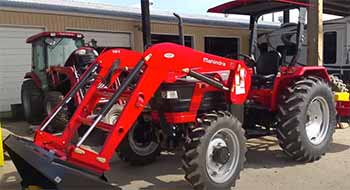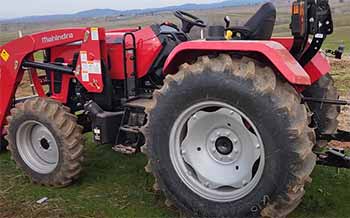If you’re in the market for a new tractor, you may be considering Mahindra’s 55 series models – the 5155 and the 5555. As similar mid-sized utility tractors, deciding between them really comes down to understanding the key differences and which features fit your specific needs.
As an experienced tractor owner myself, I’ve spent a lot of time operating both the 5155 and 5555 models over the years.
From power and lift capacity to comfort and technology, I’ll break down how these two popular Mahindra tractors compare across the metrics that matter most when investing in farm and ranch equipment.
A Brief Comparison Table
| Specs | Mahindra 5155 | Mahindra 5555 |
| Engine Horsepower | 53 HP | 67 HP |
| Engine | Mahindra mCRD 4-cylinder | Mahindra mCRD 4-cylinder |
| Total Weight | 3,080 lbs (1,400 kg) | 3,370 lbs (1,530 kg) |
| Fuel Type | Diesel | Diesel |
| Fuel Tank Capacity | 15 gallons (56L) | 15 gallons (56L) |
| Hydraulic Lift Capacity | 2,756 lbs (1,251 kg) | 2,893 lbs (1,315 kg) |
| Hitch/PTO | 540 rpm rear PTO (option: 2000 rpm) | 540 rpm rear PTO (option: 2000 rpm) |
| Transmission | 12F/12R Power Shuttle | 12F/12R Power Shuttle |
| Cruise Control | Standard | Standard |
| Mid-Mount Valve | Not Available | Optional |
| Retail Price (USD) | $19,999 | $22,999 |
Overview and Intended Use
The Mahindra 5155 and 5555 are part of Mahindra’s 5000 series, which primarily includes mid-sized general purpose row crop tractors great for small and medium farms, ranches, orchards, and hobby farms. With similar horsepower and design, both models work well for:

- General tillage and plowing
- Planting & harvesting row crops
- Mowing and cutting grass or hay
- Loading and basic front-end loader work
- Towing other equipment and implements
The 5155 generates 53 engine HP making it well suited for smaller property needs, while the 5555 offers a bit more power at 67 HP for larger acreages or heavier loads.
Both utilize Mahindra’s proven 4-cylinder mCRD diesel engines designed for fuel efficiency and durability.
If you need a tractor primarily for grass, landscaping materials handling, or hobby farming on 1-15 acres, the 5155 should meet most needs. For larger hay and row crop operations on 15+ acres, the extra power of the 5555 is likely worth the upgrade.
Power, Performance & Operation
The engine horsepower advantage of the 5555 makes it the clear winner here – 14 more HP can make a noticeable difference when working long days under heavy loads. However, the 5155 is still respectably powerful for a mid-sized utility tractor.
Acreage farmers will appreciate that extra muscle from the 5555 when pulling bigger implements like 6+ foot brush hogs, box blades, grain carts, balers, or planters – especially through dense or hilly terrain. The heavier counterweight on the 5555 also improves balance with larger 3-point loads.
Both models utilize a rotating 540 PTO shaft to transfer engine power to rear implements, with an optional 2000 rpm shaft also available. When equipped, the 5555 boasts a slightly higher hydraulic lift capacity of 2,893 lbs (1,315 kg) at lower link ends compared to the 5155 rating of 2,756 lbs (1,251 kg).
The user-friendly control layout remains very similar between models. Key features that improve overall operation include:
- No-stall Power Shuttle for smooth forward/reverse shifting
- Cruise control to maintain constant speed
- Up to 3 sets of remote hydraulic ports for attachments
- Easy-to-read illuminated instrument cluster
For simple operation and maintenance, these tractors are hard to beat – even for first-time owners.
Comfort & Ergonomics
Despite its lower horsepower, the 5155 may have an advantage when it comes to operator comfort thanks to a few small upgrades:
- Wider operator station with flat-deck layout improves legroom
- Iso-mounted platform and low-frequency seat reduce fatigue
- Better placement/design of various controls for comfort
The 5555 instead retains the previous curved hood design which angles inward and reduces overall space. Taller or wide-shouldered farmers may find the cockpit of the 5155 more accommodating for long work days.
Both models offer a basic suspension seat, though mechanical springs with adjustable rebound feel noticeably dated compared to modern pneumatic cab seats. An aftermarket upgrade is recommended for suspension and swiveling functionality to reduce back and joint pain.
Key comfort features found in both tractors include:

- Open station canopy for shade & weather protection
- Retractable seat belt with buzzer reminder
- Hand rails/grips for entry/exit and operating stability
- Floor-mounted throttle, brake, and clutch pedals
- Telescopic steering adjustment for optimal reach
Consider adding the optional hydraulic top link, drawbar trailer hitch (with brakes/lights hookup), and front counterweights for heavier 3-point loads to further improve operation and control.
For hobby farmers or weekend warriors, comfort may not be a primary concern – making the simpler ergonomics and entry/exit of the 5155 perfectly acceptable for short projects. But row-crop farmers logging 8+ hours daily will want to consider add-ons to avoid fatigue and improve the functionality over factory setup.
Technology & Automation
As entry-level utility tractors aimed at simplicity and value, technology is not a major selling point of either the 5155 or 5555. You won’t find premium touches like integrated GPS guidance, auto-steering, or touchscreen displays. However, they offer just enough core features to enhance operation and maintenance.
Both models include a digital hour meter and warning lights to monitor basic functions and track service intervals like oil changes. Easy-access servicing of filters, drain plugs, fill caps, and battery help reduce maintenance hassle.
A notable tech upgrade on 5555 models includes standard installation of electro-hydraulic 3-point position control. This allows the hitch to automatically hold a set implement height when raising/lowering – a handy convenience when attaching plows, discs, etc.
Optional e3 valve hydraulic ports are also available for 5555 tractors to activate electric over hydraulic attachments by toggle switch instead of engagement levers. This simplifies the operation of front-end loaders, backhoes, grapples, and other powered implements.
Another key upgrade is the availability of a factory-installed mid-mount valve and joystick for 5555 tractors – allowing remote hydraulic control and operation of a belly-mounted mower deck or broom with intuitive right-hand placement.
Overall the technology gap between models may be negligible for many buyers. But 5555 does edge out 5155 with some installer-friendly upgrades focused on implement control and ergonomics.
Maintenance & Ownership Costs
When comparing total cost of ownership between the 5155 and 5555 models, expense margins are relatively slim thanks to competitive retail pricing and shared components between the tractors:
5155 MSRP: $19,999 USD
5555 MSRP: $22,999 USD
That $3k price difference gets you the larger engine, heavier counterweight, and minor feature upgrades mentioned above. With only semi-annual service needs and multi-year lifespans from their drivetrains, long-term operating costs stay low for both models – usually around $2,000-$3,500 over 5 years assuming personal use levels.
Shared consumables/wear items between models include:
- Engine oil & filter changes
- Air filter & fuel filter
- Front axle oil
- Hydraulic fluid exchange
- Grease fittings
- Tires
Parts sourcing is affordable through Mahindra dealerships and online retailers with most regular maintenance able to be performed yourself in the driveway. More extensive repairs involving internal engine or transmission components may merit a trip to the dealer – but likelihood is low under normal operating conditions.
If reliability reputation across Mahindra tractors holds true, you can expect a 20+ year lifetime after proper preventative maintenance. This allows either model to easily justify the initial price with a decades long service life on small or hobby properties.
For farmers putting over 500+ hours annually onto the machine, higher property revenue and uptime obviously help offset operating expenses as well compared to personal use. But careful equipment selection for intended chores, proper maintenance, and off-season storage make both Mahindra 5000 series tractors economical assets overall.
Durability & Expected Lifespan

As mentioned above regarding total cost, Mahindra 5000 series tractors are primarily designed for longevity and durability – helping offset the relatively inexpensive purchase price with reliable performance season after season.
Expect to log 1500+ hours annually across a wide range of yard, field, and landscape projects without major issues aside from general wear and tear of consumables.
With regular oil, filter, battery changes and protection from the elements when idle, it’s common to see functional life spans over 20 years or 4000+ hours.
The key difference in longevity favoring the 5555 is that extra displacement from its larger diesel engine allows a bit more breathing room before maxing out horsepower or cylinder pressure limits. For lighter property needs, the 5155 should still outlast the typical ownership cycle despite tighter engineering margins at maximum loads.
It’s also important to note that many farmers report more impact from maintenance habits than pure hours alone – keeping systems greased, filters changed, fluids refreshed, and components wiped down make a big difference regardless of model.
Storing the tractors protected from weather and UV light during off-season also preserves seats, paint, decals, rubber lines/gaskets that degrade over time.
If you follow recommended maintenance diligently and avoid overloading implements beyond capacity – expect decades of useful service from either Mahindra model. Their durability and value help explain the rapid growth in popularity that Mahindra Tractors continues to see across rural landscapes worldwide.
Frequently Asked Questions (FAQ)
The Mahindra 5145 tractor has 43 engine horsepower. This positions it as the smallest model in Mahindra’s 5000 utility series line-up.
A new Mahindra 5145 typically retails for $17,999 USD base price. Actual sales pricing from dealers may vary depending on attachments, implements, financing terms, and promotions.
Dry weight is 3,080 lbs or 1,400 kg making the 5155 a sturdy but still easily maneuverable mid-sized tractor. The heavier 5555 tips scales at 3,370 lbs or 1,530 kg by comparison.
The Mahindra 5555 offers 67 max engine horsepower. This allows it to handle larger implements with its extra displacement over the 64 HP 5155 model.
Closing Remarks
I hope this detailed overview helps highlight the key strengths of both the 5155 and 5555 tractors. Let me know if you need any other specifics on operating either model – I’m happy to discuss or demonstrate them firsthand to buyers. Depending on your acreage size, annual usage hours, and budget – one likely suits your needs better.
Feel free to ask additional questions!

where did you find these tractors at this cost?? I am seeing the 5155 starting at $30,000